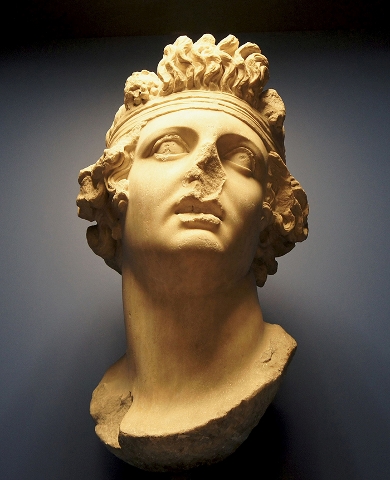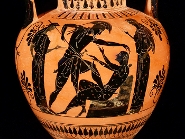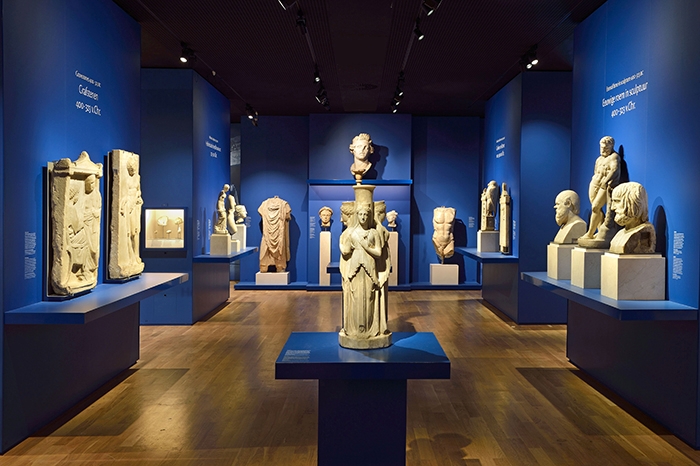
'Dionysus never looked so beautiful'
The renovated National Museum of Antiquities will re-open for the public on 15 December. Conservator Ruurd Halbertsma, Leiden Professor of Archaeology, explains why the renovation was needed: 'More visible cohesion between cultures, more context and more artistic lighting.'
Restoration and clean-up operation
The muscular torsos of the Greek and Roman gods are even more impressive in the improved lighting. Details of the clothing sculpted into the marble statues of women now come clearly into focus. 'You can see every fold,' commented curator Ruurd Halbertsma. Thanks to a major restoration and clean-up operation, the images and artefacts really come into their own. Halbertsma points to the bust of the Greek god of wine, high up in the exhibition hall. 'Dionysus never looked so beautiful.'

Exchange between cultures
The RMO had to be rebuilt because asbestos was found under the floors and behind the walls. The curator took the opportunity to completely redesign several of the museum's exhibition rooms. The Roman, Greek and Etruscan antiquities now form a more cohesive collection, and the rooms have a more logical sequence. Halbertsma: ‘In other museums, exhibitions of Greek culture often tend to be rather isolated, while our new exhibition shows that there really was a high level of exchange between the different cultures.'
Students active in museum
As well as being curator of RMO, Ruurd Halbertsma is also Professor by special appointment of Museum Aspects of Archaeology. He involves his students in the museum's activities. Many of them have worked on developing teaching material based on the new museum layout. Others help with preparing the exhibits that are held in store, for example by providing translations of Greek inscriptions on ancient tombstones. 'I see myself as something of a bridge-builder. In my lectures I often first teach the theory and then take my students into the museum to carry out assignments there. That way they learn what a museum can achieve with its exhibits.'
Greek-Indian image
Based on Halbertsma's new ideas about the exchange of cultures, some artefacts that had been kept in the museum's storeroom now warrant a place in the exhibition rooms. New loans support his ideas. To illustrate this, Halbertsma indicates a stone Buddha portrait from India, estimated to be 2,000 years old. The hairstyle and large ears are typical of Indian Buddhas, but the eyebrows, mouth and chin are 'very Greek'.

More information about everyday life
In addition, the museum now places the different objects more in context. Behind the impressive parade of Roman emperors is an enormous wall map depicting the Roman Empire. Halbertsma also points out a new wall with Athenian earthenware vases. The information panels describe aspects of the everyday lives of men and women, and talk about wars and games.

Middle Eastern War
The newly designed museum continues to focus attention on the wars and the Middle Eastern heritage that is under threat. Visitors to the pop-up Museum shop (Nieuwe Rijn 26 in Leiden) can view the Postcard from Aleppo exhibition that is open up to and including 30 December. The exhibition is an art project organised by Syrian photographer for Issa Touma for displaced persons in the city of Aleppo. A new exhibition will open in the autumn of 2016 featuring Nineve, the ruined city in the north of Iraq that has been destroyed by IS. The RMO is carrying out archaeological excavations in relatively peaceful Jordan, together with archaeologists from Leiden University. Halbertsma: ‘We hope that Jordan will remain a war-free zone, but for safety's sake all the objects excavated there will be documented even better and more completely.'
(10 December 2015)
Leiden University has been involved with the National Museum of Antiquities since its very foundation in 1818. Leiden Professor of Archaeology Caspar Reuvens was the museum's first director. The first museum collection was based largely on the University's collection of artefacts.
